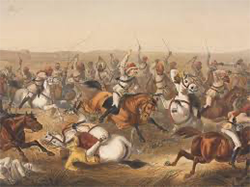Sir Robert Clive: Icon of India
Sir Robert Clive was a British soldier who solidified British rule over India in the early 19th Century. 
He was born on Sept. 29, 1725, near Market Drayton, in England. His parents, who had 13 children, sent young Robert to Manchester, to live with his aunt. She treated him incredibly favorably, and at age 9 he returned to his parents as a know-it-all. At the same time, he was a good fighter, attracted a gang of hoodlums, and began extorting local businessmen by accepting money in return for not looting their goods and property. He is also thought to have suffered from a mental illness akin to what is known today as bipolar disorder. After he got himself expelled from three schools, his father, a former MP who had fallen on hard times, sent him to India, to be a writer for the East India Company (EIC). Robert left for India in March 1743 and, after a delay, arrived in Madras in June 1744. He reported for duty at Fort St. George; French forces captured that fort in 1746 and took Clive and others prisoner. He and a handful of others soon escaped. During this time, France and Britain were also fighting in Europe, in the War of the Austrian Succession. That war ended in Europe, but the conflict in India continued. Both Britain and France tried to gain the upper hand through a variety of means, including seizing trading posts and handpicking important leaders. Clive led a force of a few hundred men in a seizure of a fort at Arcot in order to ensure that the British-backed native leader ruled it. They then withstood a withering siege and, against heavy odds, defeated a far superior attacking force; for this, he won commendations back home, even from then-Prime Minister William Pitt the Elder. Clive went back to Britain in 1753, got married (to Margaret Maskeylne), and won election to Parliament. He didn't last long in that capacity and got himself appointed governor of Fort St. David in 1755. Not long after he arrived, a local leader, the Nawab of Bengal, led a takeover of Calcutta, including seizing Britain's Fort William. The prisoners taken from the fort were thrown into a small bleak prison known as the "Black Hole of Calcutta." Clive and Vice Admiral Charles Watson led an armed attack force that retook Calcutta and rescued the few prisoners who had survived. These attacks and fort seizures took place against the backdrop of conflict between France and Great Britain at various points in the world. The two nations fought for control of eastern North America in the French and Indian War and for European dominance in the Seven Years War. They fought in Africa as well, and, of course, in India. 
Another local leader, Siraj Ud Daulah, appealed to France for help. Clive responded by taking control of the French colony at Chandernagore; this success helped Clive convince Siraj Ud Daulah's military commander, Mir Jafar, to throw in his lot with Clive and the British. As a result, British forces won the Battle of Plassey in 1757 and Jafar took the Bengali throne. Significantly, Clive managed the victory with far fewer men. Estimates are that Clive's force had just a few thousand and the opposing force had 50,000 men and 50 cannons. It was the turncoat actions of Jafar that swung the battle in Clive's favor. After a brief return to London–during which time he was elected to Parliament again, representing Shrewsbury–, and then elected mayor. He was given an honorary degree from Oxford University and gained appointment to the Order of the Bath. In 1765, Clive was back in India, serving as governor and commander-in-chief in Bengal. He put down a mutiny of the EIC army in 1765 and worked to streamline administration of Bengal. He was also known as a controversial figure, preferring harsh methods of keeping the peace. In one instance, he ordered forced cultivation of crops, which then led to famine. He also amassed a large personal fortune from his time living and working in the subcontinent. Clive left India for good in 1767, returning to Great Britain and buying a large estate named Claremont. He faced a parliamentary inquiry about his finances while in India and was exonerated. He declined the offer to be Commander-in-chief of British forces in North America in 1774. He died later that year. |
|
Social Studies for Kids
copyright 2002–2026
David White




